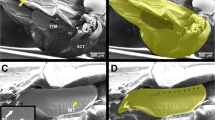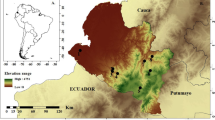Abstract
Over 70% of the droppings of the gleaning bat Otonycteris hemprichii can contain scorpion fragments. Yet, some scorpions found in its desert habitat possess venom of the highest known toxicity, rendering them a very dangerous prey. In this study, we describe how O. hemprichii catches and handles scorpions, quantify its flight and echolocation behaviour in the field, investigate what sensory modality it uses to detect scorpions, and test whether it selects scorpions according to their size or toxicity. We confirmed that O. hemprichi is a whispering bat (approx. 80 dB peSPL) with short, multi-harmonic calls. In a flight room we also confirmed that O. hemprichii detects scorpions by their walking noises. Amplitudes of such noises were measured and they reach the flying bat at or below the level of echoes of the loess substrate. Bats dropped straight onto moving scorpions and were stung frequently even straight in their face. Stings did not change the bats’ behaviour and caused no signs of poisoning. Scorpions were eaten including poison gland and stinger. Bats showed no preference neither for any of the scorpion species nor their size suggesting they are generalist predators with regard to scorpions.




Similar content being viewed by others
References
Arlettaz R, Dändliker G, Kasybekov E, Pillet JM, Rybin S, Zima J (1995) Feeding habits of the long-eared desert bat Otonycteris hemprichi (Chiroptera:Vespertilionidae). J Mammal 76(3):873–876
Arlettaz R, Jones G, Racey PA (2001) Effect of acoustic clutter on prey detection by bats. Nature 414(6865):742–745
Bazley EN (1976) Sound absorption in air at frequency up to 100 kHz in National Physics Laboratory acoustics report No Ac 74. National Physics Laboratory, Teddington, UK
Bell GP (1982) Behavioral and ecological aspects of gleaning by a desert insectivorous bat Antrozous pallidus (Chiroptera: Vespertilionidae). Behav Ecol Sociobiol 10(3):217–223
Birula AA (1908) Ergebnisse der mit Subvention aus der Erbschaft Treitl unternommenen zoologischen Forschungsreise Dr. F. Werner’s nach dem Anglo-Aegyptischen Sudan und Nord-Uganda. XIV. Skorpiones und Solifugae. Sitzungsberichte der kaiserlich-königlichen Akademie der Wissenschaften, Wien, 117(1):121–152
Brooke AP (1994) Diet of the fishing bat, Noctilio leporinus (Chiroptera: Noctilionidae). J Mammal 75(1):212–218
Daniel S (2005) Behavioral body temperature regulation and foraging activity in reproductive female Hemprich’s long-eared bats (Otonycteris hemprichii) in the Negev Desert. PhD dissertation, Ben-Gurion University of the Negev
Daniel S, Korine C, Pinshow B (2008) Central-place foraging in nursing, arthropod-gleaning bats. Can J Zool 86(7):623–626
Ehrenberg CG (1828) Symbolae physicae seu icones et descriptiones avium quae ex itinere per Africam borealem et Asiam occidentalem Friderici Guilelmi Hemprich et Christiani Godofredi Ehrenberg (…) studio novae aut illustratae redierunt. Decas prima, Mittler, Berolini
Fenton MB, Shalmon B, Makin D (1999) Roost switching, foraging behavior, and diet of the vespertilionid bat, Otonycteris hemprichii. Isr J Zool 45(4):501–506
Fuzessery ZM (1994) Response selectivity for multiple dimensions of frequency sweeps in the pallid bat inferior colliculus. J Neurophys 72(3):1061–1079
Fuzessery ZM, Buttenhoff P, Andrews B, Kennedy JM (1993) Passive sound localization of prey by the pallid bat (Antrozous p pallidus). J Comp Physiol A 171(6):767–777
Goerlitz HR, Greif S, Siemers BM (2008) Cues for acoustic detection of prey: insect rustling sounds and the influence of walking substrate. J Exp Biol 211:2799–2806
Griffin DR (1958) Listening in the dark: the acoustic orientation of bats and men. Yale University Press, New Haven, CT
Hadley NF (1974) Adaptational biology of desert scorpions. J Arachnol 2(1):11–23
Harrison DL, Bates PJJ (1991) Mammals of Arabia. Harrison Zoological Museum, Sevenoaks
Hassan F (1984) Production of scorpion antivenom. In: Tu A (ed) Handbook of toxins, Insect poisons, allergens and other invertebrates venoms. Marcel Dekker, New York, pp 577–605
Hayward MW, Henschel P, O’Brien J, Hofmeyr M, Balme G, Kerley GIH (2006) Prey preferences of the leopard (Panthera pardus). J Zool 270(2):298–313
Holderied MW, Jones G (2009) Flight dynamics. In: Kunz TH, Parsons S (eds) Ecological and behavioral methods for the study of bats. Johns Hopkins University Press, Baltimore, pp 459–475
Holderied MW, von Helversen O (2003) Echolocation range and wingbeat period match in aerial-hawking bats. Proc R Soc B 270(1530):2293–2299
Korine C, Pinshow B (2004) Guild structure, foraging space use and distribution in a community of insectivorous bats in the Negev Desert. J Zool 262:187–196
Levy G, Amitai B (1980) Fauna palaestina—archnida I—scorpiones. The Israel Society of Sciences and Humanities, Jerusalem
McCormick SJ, Polis GA (1990) Prey, predators, and parasites. In: Polis GA (ed) The biology of scorpions. Stanford University Press, Palo Alto
Møhl B (1988) Target detection by echolocating bats. In: Nachtigall PE, Moore PWB (eds) Animal sonar: processes and performance. Plenum Press, New York
Neuweiler G (1990) Auditory adaptations for prey capture in echolocating bats. Physiol Rev 70(3):615–641
Norberg UM, Fenton MB (1988) Carnivorous bats? Biol J Linn Soc 33(4):383–394
Norberg UM, Rayner JMV (1987) Ecological morphology and flight in bats (Mammalia; Chiroptera): wing adaptations, flight performance, foraging strategy and echolocation. Phil Trans R Soc B 316(1179):335–427
Orr RT (1954) Natural history of the pallid bat, Antrozous pallidus. Proc Calif Acad Sci 28:165–264
Polis GA (1991) Complex trophic interactions in deserts: an empirical critique of food-web theory. Am Nat 38(1):123–155
Russo D, Arlettaz R, Jones G (2007) Echolocation and passive listening by foraging mouse-eared bats Myotis myotis and M blythii. J Exp Biol 210:166–176
Schmidt S (1988) Evidence for a spectral basis of texture perception in bat sonar. Nature 331:617–619
Schmidt S, Hanke S, Pillat J (2000) The role of echolocation in the hunting of terrestrial prey—new evidence for an underestimated strategy in the gleaning bat, Megaderma lyra. J Comp Physiol A 186(10):975–988
Schnitzler H-U, Henson OW (1980) Performance of airborne animal sonar systems: I Microchiroptera. In: Busnel RG, Fish JF (eds) Animal sonar systems. Plenum Press, New York
Schnitzler H-U, Kalko EKV (1998) How echolocating bats search and find food. In: Kunz TH, Racey PA (eds) Bat biology and conservation. Smithsonian Institution Press, Washington, DC
Schnitzler H-U, Kalko EKV (2001) Echolocation by insect-eating bats. Bioscience 51(7):557–569
Shachak M, Brand S (1983) The relationship between sit and wait foraging strategy and dispersal in the desert scorpion, Scorpio maurus palmatus. Oecologia 60(3):371–377
Shulov A, Amitai P (1959) On the mating habits of two species of scorpions, Leiurus quinquestriatus H. & E., and Buthotus judaicus E. S. Bull Res Counc Isr (Sect B Zool) 8:41–42
Siemers BM, Güttinger R (2006) Prey conspicuousness can explain apparent prey selectivity. Curr Biol 16(5):R157–R159
Siemers BM, Schnitzler H-U (2000) Natterer’s bat (Myotis nattereri Kuhl, 1818) hawks for prey close to vegetation using echolocation signals of very broad bandwidth. Behav Ecol Sociobiol 47(6):400–412
Simmons JA (1973) Resolution of target range by echolocating bats. J Acoust Soc Am 54(1):157–173
Simmons JA, Lavender BA, Lavender WA (1974) Target and echo fine-structure discrimination by echolocating bats. J Acoust Soc Am 55(2):479
Skutelsky O (1996) Predation risk and state dependent foraging in scorpions: effects of moonlight on foraging in the scorpion Buthus occitanus. Anim Behav 52(1):49–57
Williams SC (1987) Scorpion bionomics. Annu Rev Entomol 32:275–295
Zlotkin E, Miranda F, Rochat H (1976) Venoms of Buthinae. C, chemistry and pharmacology of Buthinae scorpion venoms. In: Bettini S (ed) Arthropod venoms. Handbook of experimental pharmacology, vol 48. Springer, Berlin, pp 317–369
Acknowledgments
Bats were caught and housed under permission by the Israel Nature and Parks Protection Authority (permit # 13414 2005). We thank the Jacob Blaustein Institutes for Desert Research at BGU for providing the facilities. This is paper number 713 of the MDDE.
Author information
Authors and Affiliations
Corresponding author
Rights and permissions
About this article
Cite this article
Holderied, M., Korine, C. & Moritz, T. Hemprich’s long-eared bat (Otonycteris hemprichii) as a predator of scorpions: whispering echolocation, passive gleaning and prey selection. J Comp Physiol A 197, 425–433 (2011). https://doi.org/10.1007/s00359-010-0608-3
Received:
Revised:
Accepted:
Published:
Issue Date:
DOI: https://doi.org/10.1007/s00359-010-0608-3




